Komodo & Sumbawa
Thursday, 20 September 2018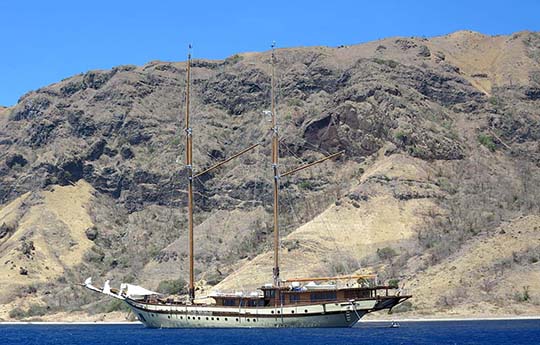 ▲ Lamima off Gili Banta Island which in turn is off the southern side of Sumbawa Island.
▲ Lamima off Gili Banta Island which in turn is off the southern side of Sumbawa Island.
Three years ago I spend some time in the Komodo Islands on a delightful Bugis-style schooner, joining and leaving the Katharina at Labuan Bajo. This time with eight friends from England we spent rather longer in a rather larger twin-masted phinisi. Lamima is a big boat, 65-metres in length and all wood. She was built in Sulawesi and then towed to Bangkok where the engineering, the tech and the fit out, ie all the luxury, were installed. We boarded Lamima in Bali – soon after the big Lombok earthquake – and left her 16 days later in Labuan Bajo, the port at the western end of the island of Flores. The Komodo Islands, sprinkled between Sumbawa and Flores, are famed for their Komodo Dragons, crocodile-sized monitor lizards.
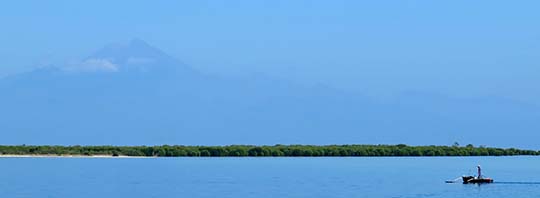
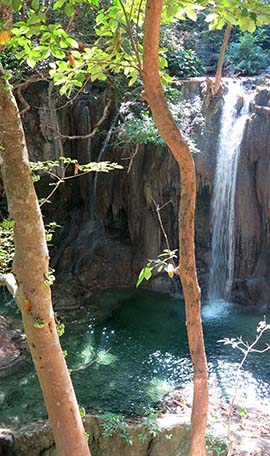 ▲ We sailed the afternoon and all night after we left Bali, turning north and then east as we crossed the Wallace Line which separates Bali from Lombok. It’s the transition line between the ecozones of Asia and Australia. That day we anchored off Pulau Keramat – Pulau is Indonesian for ‘island’ – a small island off the north coast of Sumbawa. From our anchorage we could look back to 3726 metre Mt Rinjani on Lombok.
▲ We sailed the afternoon and all night after we left Bali, turning north and then east as we crossed the Wallace Line which separates Bali from Lombok. It’s the transition line between the ecozones of Asia and Australia. That day we anchored off Pulau Keramat – Pulau is Indonesian for ‘island’ – a small island off the north coast of Sumbawa. From our anchorage we could look back to 3726 metre Mt Rinjani on Lombok.
◄ The next day we were off Pulau Joyo, a rather larger island off Sumbawa. From the village of Labuhan Aji we recruited a pack of local motorcyclists to take us inland to the beautiful Matu Jitu waterfalls. Our next stop was Satonda Island, still off Sumbawa, which features a salty lake, the result of the gigantic eruption of Mt Tambora in 1815. It was a far larger eruption than better known Krakatoa in 1883 but, like Krakatoa, it effected weather around the world.
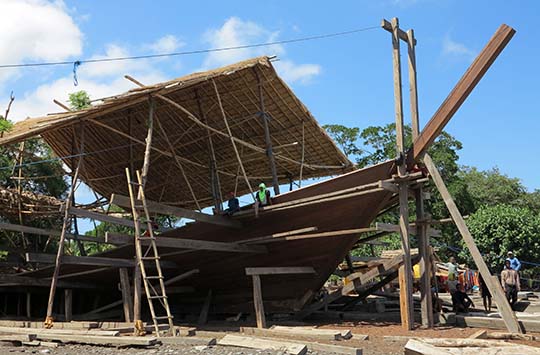 ▲ On the beach at Pulau Sangeang, our next stop, a big wooden boat was under construction. The craftsmen and the wood all came from Sulawesi although the buyer was a local Sumbawan trader. It was an impressively large project for something being built totally by traditional methods.
▲ On the beach at Pulau Sangeang, our next stop, a big wooden boat was under construction. The craftsmen and the wood all came from Sulawesi although the buyer was a local Sumbawan trader. It was an impressively large project for something being built totally by traditional methods.
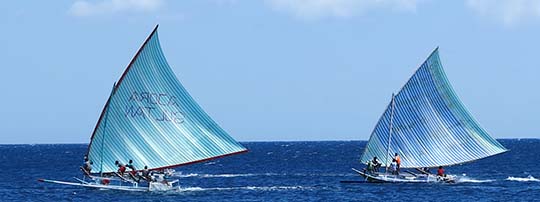
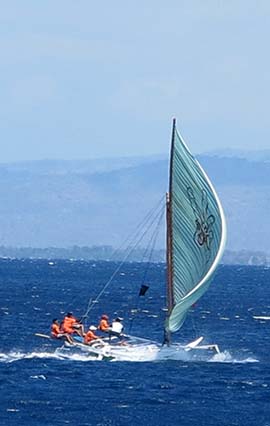 ▲ Drawn up on the beach were double outrigger jukung sailing canoes. In frenetic flurries of activity they set off in groups of five to race about seven km to the Sumbawa mainland.
▲ Drawn up on the beach were double outrigger jukung sailing canoes. In frenetic flurries of activity they set off in groups of five to race about seven km to the Sumbawa mainland.
◄ It’s one thing seeing these traditional sailing boats set out on fishing trips, but clearly they can move with dramatic speed when their crew are in a racing mood.
 ▲ Sangeang is an active volcano and the island’s villagers were evacuated when an eruption threated in 2014. We sailed off to Gili Banta for another day of sea and beach, I was managing a scuba dive every day. That night we looked back to a sunset – we had lots of dramatic sunsets – with the Sangeang volcano cone puffing up little ‘yes this is indeed a volcano’ smoke clouds to complete the picture. Just like on my 2015 Komodo visit we went dragon watching on Rinca Island …
▲ Sangeang is an active volcano and the island’s villagers were evacuated when an eruption threated in 2014. We sailed off to Gili Banta for another day of sea and beach, I was managing a scuba dive every day. That night we looked back to a sunset – we had lots of dramatic sunsets – with the Sangeang volcano cone puffing up little ‘yes this is indeed a volcano’ smoke clouds to complete the picture. Just like on my 2015 Komodo visit we went dragon watching on Rinca Island …
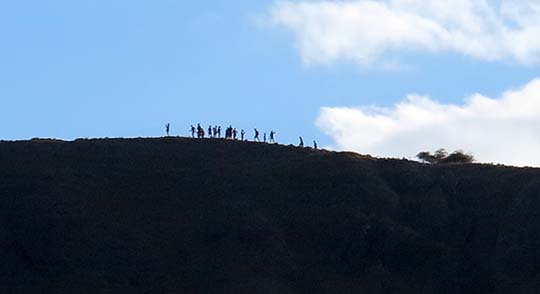 ▲ … and then anchored off Pulau Padar where, like other visitors, we climbed up the island’s ridgeline to the high point for sunset
▲ … and then anchored off Pulau Padar where, like other visitors, we climbed up the island’s ridgeline to the high point for sunset
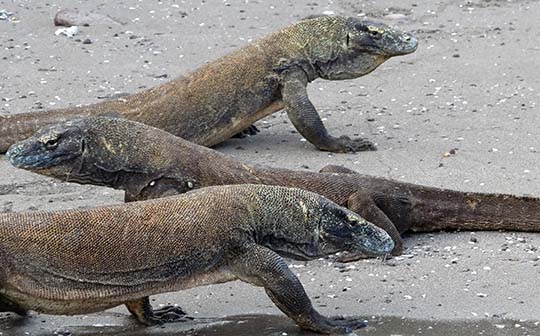 ▲ The next morning we were anchored south of Rinca Island at Lehok Uwasa Dasami – Loh Dasami Bay – to see the dragons which congregate on the beach. From here we planned to sail south to Sumba, an island famed for its ikat weaving, where the threads are dyed before the weaving takes place. Sumba is the only major island in the Nusa Tenggara group I hadn’t previously visited, but sadly it remains on my ‘must do’ bucket list. The currents around the Komodo Islands are notoriously strong – all that water sloshing back and forth between the Indian and Pacific Oceans – and a few hours out from Rinca it was clear the conditions were against us. We were fighting against the oncoming current and weather predictions didn’t look good, so we turned back.
▲ The next morning we were anchored south of Rinca Island at Lehok Uwasa Dasami – Loh Dasami Bay – to see the dragons which congregate on the beach. From here we planned to sail south to Sumba, an island famed for its ikat weaving, where the threads are dyed before the weaving takes place. Sumba is the only major island in the Nusa Tenggara group I hadn’t previously visited, but sadly it remains on my ‘must do’ bucket list. The currents around the Komodo Islands are notoriously strong – all that water sloshing back and forth between the Indian and Pacific Oceans – and a few hours out from Rinca it was clear the conditions were against us. We were fighting against the oncoming current and weather predictions didn’t look good, so we turned back.
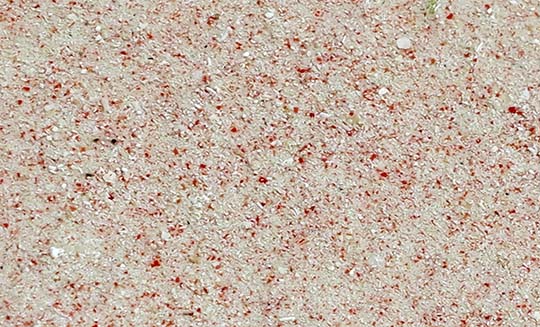 ▲ We anchored off a small island – not much more than a sandbar – in the Makassar Reef. Like Komodo’s well known Pantai Merah – Pink Beach, although merah actually means ‘red’ – the sand is indeed a fine shade of pink, a result of ground up red coral. The channel over the Makassar Reef is noted for its manta rays and snorkeling is all it takes to join these wonderful creatures. I’d encountered them on my 2015 visit as well and over the years I’ve swum with manta rays in quite a few places including Bora Bora in French Polynesia, the Ningaloo Reef in Western Australia and Uepi in the Solomon Islands.
▲ We anchored off a small island – not much more than a sandbar – in the Makassar Reef. Like Komodo’s well known Pantai Merah – Pink Beach, although merah actually means ‘red’ – the sand is indeed a fine shade of pink, a result of ground up red coral. The channel over the Makassar Reef is noted for its manta rays and snorkeling is all it takes to join these wonderful creatures. I’d encountered them on my 2015 visit as well and over the years I’ve swum with manta rays in quite a few places including Bora Bora in French Polynesia, the Ningaloo Reef in Western Australia and Uepi in the Solomon Islands.
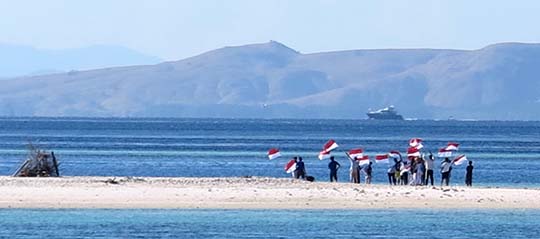 ▲ A day later we were anchored off that sandy island again, as a group of Indonesians paraded along the island waving Indonesian flags to celebrate Independence Day.
▲ A day later we were anchored off that sandy island again, as a group of Indonesians paraded along the island waving Indonesian flags to celebrate Independence Day.
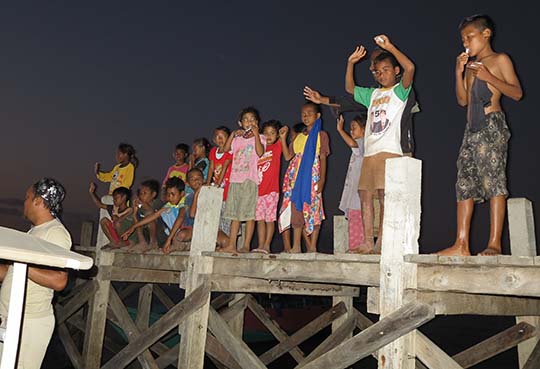
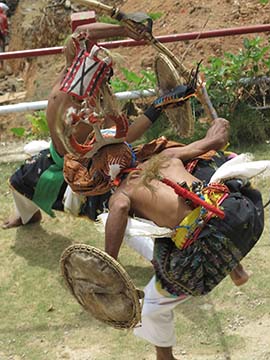 ▲ In between we’d visited the village on Pulau Papagaran where a fiercely fought football match was taking place between two women’s teams. The younger women won. This group of kids came down to the jetty to wave us off as we headed back to Lamima.
▲ In between we’d visited the village on Pulau Papagaran where a fiercely fought football match was taking place between two women’s teams. The younger women won. This group of kids came down to the jetty to wave us off as we headed back to Lamima.
◄ Our last few days featured more beaches, more scuba diving and finally a ride up into the hills above Labuan Bajo to visit the Batu Cermin caves and then the village of Cecer and this traditional fighting event. After which we left the boat and flew off, most of us to Singapore.






